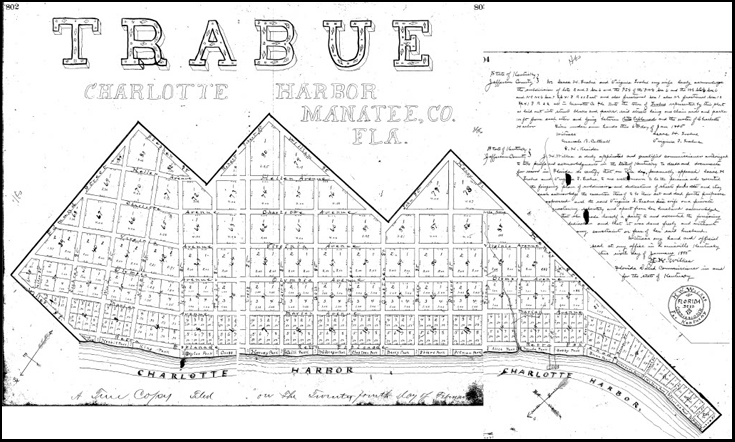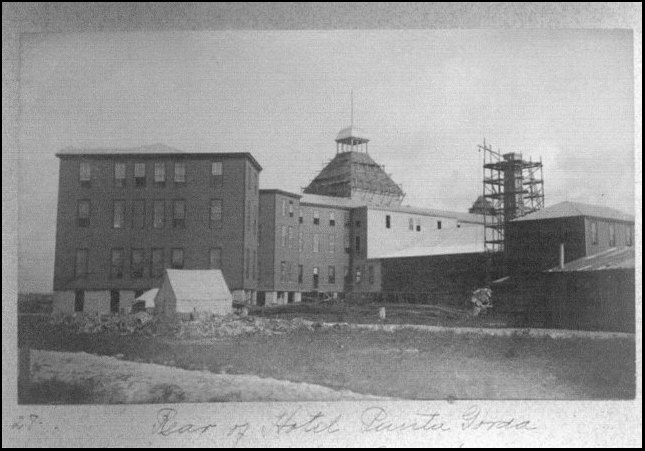Year
2023
Artist
Location
Baker Center School
311 E. Charlotte Avenue
Size
104′ w x 8.5′ h
Mural Creation Sponsors
2023:
Sushila Cherian
In Memory of Dr. JV Cherian
Congregational United Church of Christ
Kelly & Pete Gaylord
The Patterson Foundation
Saint Mary Baptist Church
In Memory of Pastor Isaac Thomas Jr
Community Foundation of Sarasota County
Shively Charitable Foundation
Lt. Col. Scot & Jill Shively
Penny Stiffler
The Community
Panel 1 – The Early Years
To listen to an audio presentation of the history captured in this panel, click on this video.
Colonel Isaac Trabue purchased an initial 30 acres on the south side of the Peace River sight unseen in 1883. He hired surveyor Kelly Harvey to layout his future settlement, and the plat for the town of “Trabue” (later renamed “Punta Gorda”) was recorded on February 24, 1885.

Isaac needed a railroad to service his new town to make it viable. He convinced the Florida Southern Railroad to do so after tough negotiations that included deeding half of his initial land holdings to the company.
Building south from Bartow, the railroad surveying crew worked ahead of the reported 1,000 men laying steel rails. The seven-person all-black surveying crew was led by Albert Gilchrist. They completed the survey by late September 1885 and the last rail was laid in Punta Gorda by July 24th, 1886. Regular train service began, bringing northerners to the southern-most rail terminal in the states.
Here’s an except from a September 28, 1939 Punta Gorda Herald interview with Dan Smith, a member of Gilchrist’s surveying crew: “I…came…to Punta Gorda in 1885 with General Gilchrist who brought a bunch of us–Sam Kenedy and five others, Graham, Fuller, and Ransom being three of them–to grub and clear the land for the town. We got here a week ahead of the railroad tracks, though the grade had been completed to this point and the track had been laid to Cleveland.”
“A gang of eight white men, inclusive of their boss, a man named Pittman, were put to work building the long dock two miles below town that was to be the railroad terminal. With our gang, it made a population of 15 here then. All camped in front of where Hotel Charlotte Harbor [formerly Hotel Punta Gorda] now stands.” “After the railroad tracks were finished, we occupied the section houses that were built. Things began to get pretty lively then, with people coming and going on the railroad. Sam Kenedy and I helped unload the first car of bricks used in the foundation of the big hotel.”
The Florida Commercial Co., a subsidiary of the Florida Southern, immediately started work on constructing the Hotel Punta Gorda on the land deeded to the railroad. Besides lumber and marl fill, the train also brought workmen, said to be 200 in number and majority black, to build the massive hotel.

“In the Hotel Punta Gorda construction, a spur railroad track was put down and dirt hauled in from Cleveland and Shell Creek to fill in King Street [now Rt 41N] and the saw grass. Rock from the Fort Meade district was brought for the sea wall. In order to give sufficient ground room, the hotel was set as near Marian Ave. as possible. The mess and sleeping barracks were built out to the Marian Ave. street line,” recalled then resident Kelly Harvey in a letter dated January 2, 1924.
The hotel opened in January 1888. Most of surveying crew settled in Punta Gorda, as the rails were not extended further south until 1904. Fishing became the main occupation, sailing sharpie boats docked at what became known as “Sharpie Town” east of town at the water’s edge end of Cooper Street.
This is the history captured in this first panel of the Local Black History mural.






 Support Provided by the Community Foundation of Sarasota County & the Shively Charitable Foundation
Support Provided by the Community Foundation of Sarasota County & the Shively Charitable Foundation